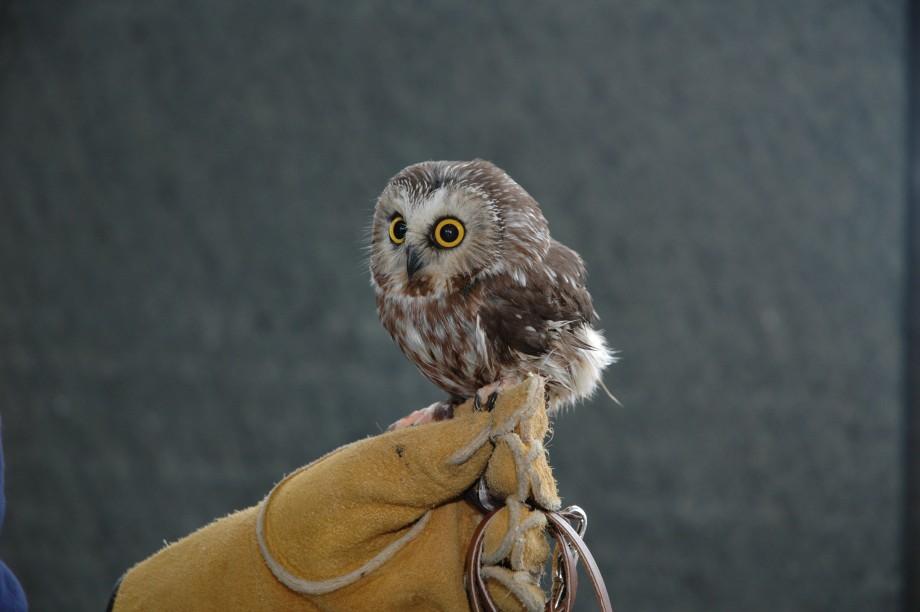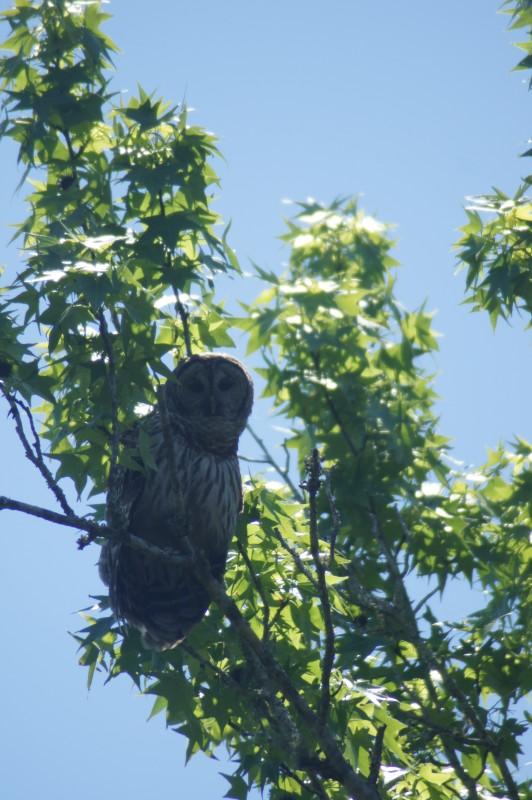My friend Sean and I went out one crisp April Adirondack night in search of owls. Owls as a rule breed earlier than most birds, allowing them to take advantage of young rodents and other prey items in spring when the owls themselves have young or when their young are recently fledged and learning to hunt for themselves.
Although we were looking for anything we could find, our target species was the saw-whet owl – a small species about eight inches long and generally weighing between 2.5 and 3 ounces. It is the smallest owl in the region.

While some saw-whets overwinter in the Adirondacks and their vicinity – particularly in years like this winter with warm temps and little snow – most migrate south in the fall to lower elevations and areas like the mid-Atlantic states. Growing up in that area, I used to find saw-whets wintering in the pine barrens of South Jersey and in Southeast Pennsylvania.
Saw-whets return in the spring, and April is the height of their movement into and through the region, joining birds that may have spent the winter here. Setting up territories and looking for mates, they call incessantly in a hormone-driven fervor. It is the easiest time of year to find them as a result.
Although they breed in a variety of habitats, saw-whets often prefer coniferous forests, and Sean and I set out on Blue Mountain Road north of Paul Smiths as the habitat there is particularly nice for saw-whets. We slowly wound along the bumpy dirt road for several miles before stopping and getting out of the car to listen.
"I've got one," exclaimed Sean almost immediately. Saw-whets do not hoot, but rather give whistled toots (which are easily imitated) about twice per second. The monotony of their calls – particularly at a distance when individual toots are difficult to tell apart from each other – can make them blend into the background noises of the landscape. Birders often find themselves straining to listen for saw-whets and even imagining they are hearing distant owls as a result.
But our bird was distinctly tooting – it was distant enough for the individual toots to almost run together, but we could still tell them apart. We stopped at short intervals down the road to see if we were getting any closer to the owl. The bird was well off the road to our left, but the exact direction of such calls can be difficult to pin down. When we got a bit closer, we stood on the dark road listening to its toots growing subtly louder and softer as the bird turned his head – broadcasting in all directions to females. Human males would likely be happy if it was that easy for them to find a mate. I suspect any guy who wanted to attract women by sitting in the woods tooting (pun intended) would find his efforts disappointing.
We drove a bit further down the road and could still hear the saw-whet's distant, ceaseless calling. Then a great-horned owl hooted softly – sounding like it was on the other side of the St. Regis River. Great-horneds are large owls and would make a meal of a saw-whet if it could surprise one.
We continued to a trailhead where we commonly birdwatch during the day, and there was another saw-whet tooting. It sounded like it was calling from a nearby pond that was also filled with the calls of spring peepers and wood frogs, and we hiked in for a closer listen. We did get closer, but the distance of sounds in open space and at night is misleading and difficult to determine, and we were never sure if the bird was on the far side of the pond from us or not – at least it sounded like it was.
Still further down the road was another saw-whet tooting – this one closer than either of the others. Figuring this may give us a chance to see an owl, we hiked in along a wide path, the sound growing louder. We stopped very close to where the owl was calling - it's nearby toots almost piercing to our ears as he put out the vibe for the ladies. I tooted back to draw him in for a look – they are often quite responsive – but this male was in the zone and not to be deterred from his quest by some bumbling imitator.

We stood transfixed in the otherwise silent world under a star-filled sky and listened to the little owl persistently announce his availability and intention to find a mate. He carried the confidence and brazenness of a man who steps onto an empty dance floor to dance alone, in the hopes that someone will eventually join him. I think we could have stood there for hours listening to his solo.
Further down the road we heard a fourth saw-whet in the distance and Sean hooted for barred owls, hoping to invoke a response. We had given up on this, but then just as we were about to get into the car a far-off barred owl answered – our third owl species of the night. Barred owls are the most common Adirondack owl, and the most commonly seen and heard in the region as a result.
As we drove back down the gravel road toward home, we stopped briefly at the trail and the pond to hear both owls still incessantly tooting. We stopped again where we had our first owl too and this time we heard not one, but two owls calling, one distant and one closer to the road – bringing us to a total of five saw-whets on the evening. We would have enjoyed searching for more, but it was already late and we would be in bed well past midnight as is was. We found a snowshoe hare on our drive home to round out our night's findings, happy with our successful venture.




